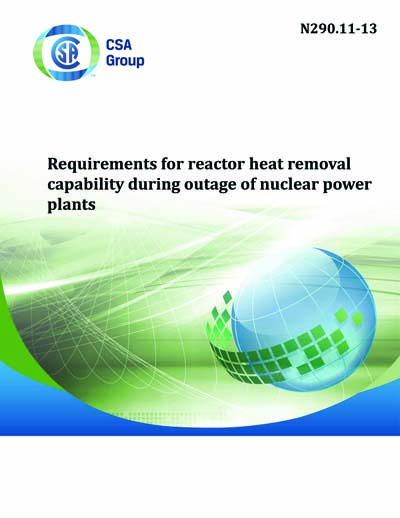Historical
CSA N290.11-2013
N290.11-13 - Requirements for reactor heat removal capability during outage of nuclear power plants
Preface
This is the first edition of CSA N290.11, Requirements for reactor heat removal capability during outage of nuclear power plants. The CSA N-Series of Standards provides an interlinked set of requirements for the management of nuclear facilities and activities. CSA N286 provides overall direction to management to develop and implement sound management practices and controls, while the other CSA nuclear Standards provide technical requirements and guidance that support the management system. This Standard works in harmony with CSA N286 and does not duplicate the generic requirements of CSA N286; however, it may provide more specific direction for those requirements. This Standard reflects the operating experience of the Canadian nuclear power industry. Users of this Standard are reminded that the design, manufacture, construction, commissioning, operation, and decommissioning of nuclear facilities in Canada are subject to the provisions of the Nuclear Safety and Control Act and its supporting Regulations.Scope
1.1 This Standard covers the design, qualification, installation, commissioning, operation, maintenance, testing, inspection, and documentation requirements for systems providing heat removal from the reactor core to the ultimate heat sink(s) for water-cooled nuclear power plants during outages. 1.2 This Standard covers only fuel cooling within the reactor core and does not cover spent fuel pool cooling, off-reactor fuelling operations, or the completely defueled core state. 1.3 The term outage refers to the following reactor states: a) a shutdown state where subcriticality is assured by physical means; or Note: For CANDU reactors, this refers to a guaranteed shutdown state. b) critical or sub-critical at any power where the normal (at high power) heat sinks are not the primary heat sinks. Note: Examples of high power heat sinks include steaming of boilers to turbine or condensers. 1.4 For the purposes of this Standard, the outage commences when the normal (at high power) heat sinks are no longer the primary heat sinks. The outage is considered to be terminated when the normal (at high power) heat sinks are re-established as part of the plan to proceed to sustained high power operation. 1.5 This Standard covers all systems that contribute to the transfer of heat by a) conveying heat to the ultimate heat sink; b) providing power or compressed air; c) providing inventory makeup to heat sink systems; or d) monitoring and control. Note: The combination of systems or portions of systems that contribute to these functions are referred to in this Standard as heat sinks. 1.6 In this Standard, shall is used to express a requirement, i.e., a provision that the user is obliged to satisfy in order to comply with the standard; should is used to express a recommendation or that which is advised but not required; and may is used to express an option or that which is permissible within the limits of the standard. Notes accompanying clauses do not include requirements or alternative requirements; the purpose of a note accompanying a clause is to separate from the text explanatory or informative material. Notes to tables and figures are considered part of the table or figure and may be written as requirements. Annexes are designated normative (mandatory) or informative (non-mandatory) to define their application.Content Provider
CSA America, Inc. [csa]






